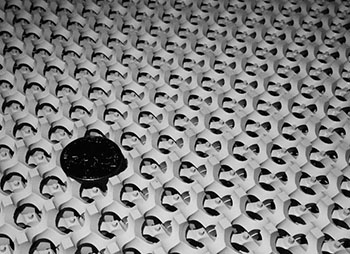
The MIT-Zhejiang University used a highly engineered photonic crystal structure to isolate Weyl fermions. [Image: Ling Lu, MIT]
For some 85 years, particle physicists have sought evidence of a massless particle, the so-called Weyl fermion, to patch a nagging hole in the solutions for the Dirac equation. Last week, two separate groups reported that they had finally isolated the elusive particle, using different techniques (Science, doi: 10.1126/science.aaa9297, 10.1126/science.aaa9273). The discoveries not only culminate a long search, but, in the view of the scientific teams involved, they also open up the prospect of interesting new physics that could boost the efficiency of electronics and extend photonic applications as well.
Missing link in the Dirac equation
Weyl fermions were first proposed in 1929 by Hermann Weyl as a massless solution to Paul Dirac’s relativistic quantum wave equation. The Dirac equation has already proved a fruitful source of exotic new particles; it predicted the existence of the positron, for example, which was discovered in 1932, and it helped drive the search for the neutrino, not discovered until 1957.
Indeed, for many years neutrinos—believed to be massless—were themselves thought to be the missing Weyl fermions predicted by the Dirac equation. But increasing evidence emerged that neutrinos might have mass, and the Japanese-American Super-Kamiokande Collaboration’s 1998 discovery of neutrino oscillations (possible only if neutrinos have nonzero mass) effectively sealed the case. The search for the massless Weyl fermions was back on.
Two routes to Weyl
The two research teams that have reported finding Weyl fermions arrived at them through different techniques—one involving a highly engineered, layered photonic crystal, the other involving a bulk semimetal with unusual topological order.
The photonic-crystal approach, used by scientists from the Massachusetts Institute of Technology (MIT), USA, and Zhejiang University, China, rests on several predictions of the Weyl Hamiltonian—the quantum-mechanical solution to the Dirac equation proposed by Weyl. Specifically, the group found in previous work that, for a photonic crystal with a particular structure and in which time or parity symmetry was broken, the Weyl Hamiltonian predicts that photons passing through the crystal would behave as Weyl fermions. The behavior would be manifest, the earlier work suggested, in a highly specific signal in momentum space: two linear dispersion bands, intersecting at a single degenerate point, the so-called Weyl point.
Building on these predictions, the team fashioned the modeled structure—a “double-gyroid photonic crystal with broken parity symmetry”—out of slabs of twenty layers of carefully machined and drilled, ceramic-filled plastics. When light was shone through the structure, the outgoing signal, analyzed in momentum space, clearly showed the signature of Weyl points: degenerate points where two linear dispersion bands meet.
The second group—consisting of scientists from Princeton University, Los Alamos National Laboratory, Oak Ridge National Laboratory, and Northeastern University USA; Peking University, China; National Taiwan University; and National University of Singapore—built on previous theoretical studies suggesting that Weyl fermions could exist in a specific synthetic semimetallic bulk crystal, tantalum arsenide, which had topological properties favorable to the hypothesized particle.
In particular, Weyl points in the metal would be associated with a chiral charge, or “handedness,” tied to the particle’s quantum spin, that could be revealed through angle-resolved photoemission spectroscopy in the vacuum ultraviolet and soft X-ray bands. The group used extensive computer simulation to zero in on the structure most likely to host the fermions, and then fashioned the crystal in the lab. The expected spectroscopic signature of the chiral anomaly emerged, signaling that the material was indeed a “Weyl semimetal.”
New photonic and electronic applications?
While these experiments constitute the first glimmers of evidence for Weyl fermions, the two scientific teams involved have made some bold claims regarding future applications. The scientists behind the photonic-crystal approach, for example, have suggested that the discovery of Weyl points in the crystal “paves the way to absolutely new photonic phenomena and applications,” including 3-D materials offering high angular selectivity for light passage, and new types of more powerful, single-frequency lasers.
The team that demonstrated Weyl points using bulk tantalum arsenide, meanwhile, suggests that their discovery could lead to “many fascinating topological quantum phenomena” and could prove useful in quantum computing and similar applications. In particular, the massless nature of the particles, their high mobilities, and their chiral anomalies suggest that they could potentially act as “massless electrons” immune from backscattering, providing a substantial boost to efficiency in computing environments. “The physics of the Weyl fermion are so strange,” says team leader M. Zahid Hasan of Princeton University, “there could be many things that arise from this particle that we're just not capable of imagining now.”

